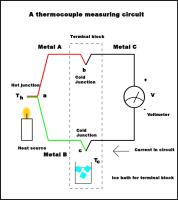 Add My Company
Add My Company
Sign In
Thermocouple Temperature Sensors
21-09-2018

This article explains basic concepts and terminology of thermocouple temperature sensors.
Thermocouples are widely used to measure temperature as they are inexpensive, simple, durable,extremely repeatable, relatively accurate and measure a wide range of temperatures.
Thermocouples temperature sensors consist of two different wires made of specially selected metals or alloys. The wires are joined at one end and this end forms the actual sensor and measurement point. Often this joint is placed in the tip of a specially constructed temperature probe for protection. The open circuit voltage, or "emf", measured across the other "open" ends of the two thermocouple wires is approximately proportional to the temperature difference between the location of the probe (the joined end of the two wires) and the point where the "open" end is located.
Thermocouples are inexpensive, simple, durable, extremely repeatable, and relatively accurate. They can measure temperatures from nearly absolute zero to about 2500 degrees C (about 4500 degrees F). A few important comments will help "understand" thermocouples and the terminology, namely:
1.The metals used for the wires sometimes have names that are not common at all. It is therefore easier to refer to thermocouples constructed of specific metal combinations by a capital letter (K, J, B, E, R, S.....etc.). The letter symbols are internationally accepted as names for thermocouples.
2.The wires used for specific thermocouple types often have insulation which is colour-coded. It is then easy to tell different types of thermocouple apart in practical installation.
3.Maximum thermocouple voltages are in the region of 20 to 80 milliVolts, over the temperature range that typically spans 0-1000 or 0-2000 degrees C. This means that the measured voltage changes only a few to a few tenths of microvolts for every degree.
4.Since ambient temperature at the measurement location (the open ends of the thermocouple wires) can vary, the measured voltage will also vary. In order to obtain an absolute reference, thermocouples are calibrated with the open end at exactly 0 degrees C. The open end is often referred to as the "Cold Junction" since traditionally an ice bath (mixture of water and ice) was used in order to maintain this temperature.
5.In modern instruments, the thermocouple reading is automatically adjusted for the fact that this "reference" (Cold Junction) temperature is not actually immersed in an ice bath and therefore differs from 0 degrees C. This is referred to as "automatic cold-junction compensation (CJC)". However, thermocouple wires must run right up to the instrument terminals. They cannot be terminated at the terminal block rail, with copper wires running to the instrument, as the instrument would then read the temperature of copper wires, and this could be at a different temperature to the open end of the thermocouple wires.
6.If thermocouple wires have to be extended, this must be done with wires made of the same (or similar) metals or alloys. These are normally referred to as "compensation cables".
7.Over any temperature range, the thermocouple measured emf is not exactly proportional to temperature. Fortunately this non-linear behaviour is repeatable, and is well documented in the standards for thermocouples. This nonlinearity can spoil potential accuracy of the temperature measurement, if not taken into account. Modern instruments are typically able to linearise the readings and make them exactly proportional to temperature.
8.Thermocouple linearisation is based on Calibration Tables. These tables characterise each thermocouple type, giving the exact reading in microvolts, at one degree C steps, when the Cold Junction is exactly at 0 degrees C. Always refer to the reference tables when in doubt about the accuracy of thermocouple readings.
For more information on Thermocouple Temperature Sensors talk to Omniflex UK Limited
Enquire Now
List your company on FindTheNeedle.

